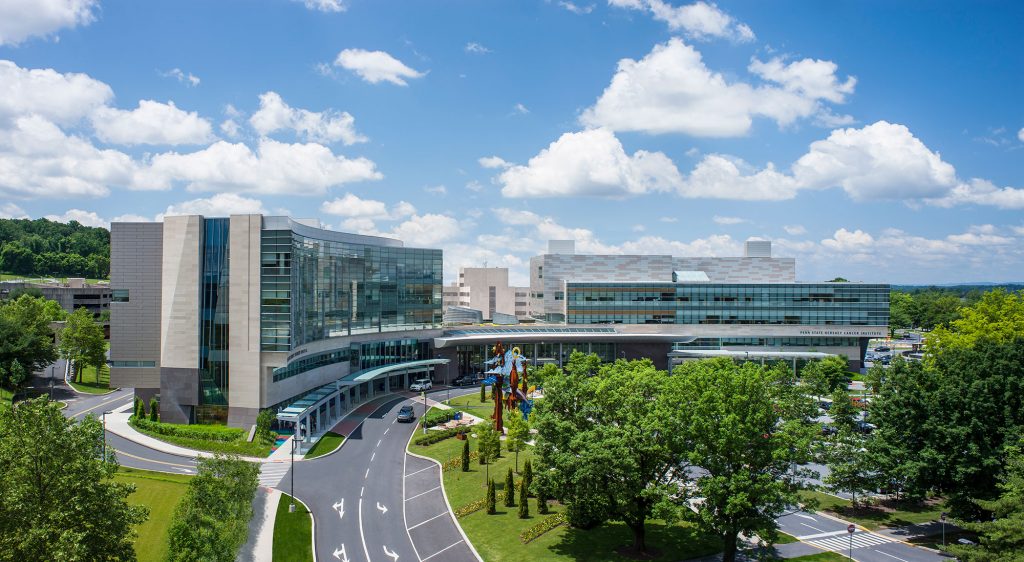Jump to topic
Search
Program Details
The integrated Interventional Radiology Residency, a program of the Division of Cardiovascular and Interventional Radiology in Penn State Medicine’s Department of Radiology, is a five-year program that begins after the successful completion of an internship year. The goal of the residency is to train individuals for independent practice in a private, academic or military practice setting.
There are more than 50 faculty members, including at least five who are CAQed interventional radiologists.
The first three years of the program provide a solid training experience in all subspecialties of diagnostic radiology, as well as three months in interventional radiology. In the final two years of training, the resident will embark on interventional radiology-specific training. This includes formal clinical and procedural training in the IR suite, as well as time in IR-specific clinics. In addition to a month in the intensive care unit, residents will rotate with clinical services that have a history of working closely with IR not only at Penn State Health Milton S. Hershey Medical Center, but also wherever a graduate chooses to practice. Upon completion of training, graduates will be prepared to enter the multi-faceted specialties of diagnostic and interventional radiology. Residents receive training in all aspects of the modern interventional radiology practice.
Vascular and non-vascular interventions will include, but are not limited to:
- Diagnostic and interventional arteriography and venography
- Oncologic and transplant interventions
- Embolotherapy
- Vascular access and dialysis access management
- IVC filter placement and complex IVC filter retrieval
- Percutaneous biliary interventions (including choledochoscopy)
- Genitourinary interventions
- Gastrointestinal interventions
- Vascular malformation interventions
- Venous insufficiency interventions
- Transjugular intrahepatic porto-systemic shunt creation and management
- Women’s health interventions
- Complex drainage procedures
- Non-invasive vascular imaging (vascular ultrasound, CT angiography, MR angiography)
Residents spend dedicated time in IR clinics, where a variety of patients are seen for pre-procedure evaluation and post-procedure follow-up.
Interventional radiology-related rotations encourage a multidisciplinary approach to training. A close working relationship exists, encompassing the clinical and academic activities of the Division of Interventional Radiology and the Department of Radiology and various specialties in the both the medical and surgical realms. In addition to rotations with referring clinical services, participation in multi-specialty treatment planning conferences contribute to the development of a resident’s clinical skills as well as the understanding of IR’s role in the patient’s global clinical care.
Research is an integral part of the residency, providing the opportunity to explore, in greater depth, specific aspects of an interventional radiology practice and procedures.
Participation in the Quality Assurance (QA) process, including a QA project, is an important and required component of residency training, intended to maintain and improve overall patient care.
For those with an interest in medical education, there are institution-wide and departmental opportunities to learn how to be an educator, as well as to actively participate in the education of Penn State College of Medicine medical students.
Because three of the five years in residency are spent in diagnostic radiology, those interested should also explore the Diagnostic Radiology Residency program to learn more about the diagnostic radiology component of interventional radiology training.
Learn More about the Residency
General Application Information
Applications to the integrated Interventional Radiology Residency must be made through ERAS (the Electronic Residency Application System).
Candidates for residency are considered during the fourth year of medical school. On rare occasions, consideration can be made during or after the internship year.
Interview Process
A personal interview is required for admission. After review of submitted applications, selected candidates are invited to Hershey for interviews.
All positions are filled through the National Residency Matching Program.
Program Prerequisites
The residency is a five-year program (PGY-2 to PGY-6). All residents will need to complete a clinical year (PGY-1) of ACGME-approved training. This year must be accredited clinical training in internal medicine, pediatrics, surgery or surgical specialties, obstetrics and gynecology, neurology, family practice, emergency medicine or any combination of these. This clinical year will usually be the first post-graduate year. No more than a total of three months may be spent in radiology, radiation oncology and/or pathology.
Although not a prerequisite, a month in the intensive care unit during the intern year is encouraged. All clinical training must take place in an ACGME-approved program.
Virtual Tour
Penn State Health
Penn State Health is a multi-hospital health system serving patients and communities across 29 counties of Pennsylvania. Its mission is to improve health through patient care, research, education and community outreach.
In December 2017, the system partnered with Highmark Health to facilitate creation of a value-based, community care network in the region. The shared goal of Highmark and Penn State Health is to ensure patients in the community are within:
- 10 minutes of a Penn State Health primary care provider
- 20 minutes of Penn State Health specialty care
- 30 minutes of a Penn State Health acute care facility
Learn more about Penn State Health

Penn State Health Children’s Hospital (left), Penn State Health Milton S. Hershey Medical Center (center) and Penn State Cancer Institute (right)
Penn State Health Milton S. Hershey Medical Center
500 University Dr., Hershey, Pa., 17033 (Derry Township, Dauphin County)
- The health system’s 647-bed flagship teaching and research hospital
- The only medical facility in Pennsylvania accredited as both an adult and a pediatric Level I (highest-level) trauma center
- Dedicated surgical, neuroscience, cardiovascular, trauma and medical intensive care units
- Accredited Life Lion critical-care transport providing more than 1,100 helicopter and approximately 750 ground ambulance transports per year
- More than 1,300 faculty members and more than 650 residents and fellows
- Approximately 29,000 admissions, 73,000 emergency department visits, 1.1 million outpatient visits and 33,000 surgical procedures annually
- Designated as a Magnet hospital since 2007
Learn more about Milton S. Hershey Medical Center
Penn State Health Children’s Hospital
600 University Dr., Hershey, Pa. 17033 (Derry Township, Dauphin County)
- An eight-story, 263,000-square-foot-facility built in 2013 and expanded in 2020
- 146 licensed pediatric beds, 18 acute care beds and a 56-bed neonatal intensive care unit
- Level IV (highest-level) neonatal intensive care unit
- Level I quaternary (highest-level) pediatric intensive care unit
- Level I (highest-level) pediatric trauma center designation
- Intermediate care unit
- Dedicated pediatric operating rooms
- More than 150,000 pediatric outpatient visits and approximately 5,000 pediatric patient discharges annually
Welcome to Hershey
More About Hershey
Interested in learning more about living and working in Hershey, Pa.? See details here:
Wellness, including emotional, spiritual, social and physical health, is a crucial component to training and to becoming a professional, compassionate and resilient physician. Self-care is a skill which must be continually practiced and reinforced. Penn State College of Medicine and Penn State Health are committed to addressing wellness among residents and fellows, with multiple resources readily available.
Institutional resources
- Visit BeWell – a health program designed to support Penn State Health employees
- See Penn State College of Medicine wellness resources here
- Employee Health Care Concierge and Case Management Service
- Partners in Medicine
Moving to a new city with your family does not have to be stressful. Residency programs have assisted many significant others with finding employment. There is also a GME-Wide Partners in Medicine (PIM) group that offers networking opportunities as well as various social and community oriented activities. - The Doctors Kienle Center for Humanistic Medicine
- Active and easily accessed Office of Professional Mental Health
Graduate medical education resources
Institutional Resources
Penn State Health and Penn State College of Medicine celebrate, embrace and support the diversity of all patients, faculty, staff, students and trainees.
Office for Diversity, Equity and Inclusion
In keeping with this, Penn State Health has an active Office for Diversity, Equity and Inclusion with various programs, networks and resource groups, including:
- Talks and lectures on diversity, equity and inclusion through the Inclusion Academy
- Regular events on topics such as eradicating racism and creating a culture of inclusiveness
- Many Business Employee Resource Groups (BERGs), including:
- Disability Business Employee Resource Group
- Interfaith Business Employee Resource Group
- LGBTQ+ Business Employee Resource Group
- Military and Veterans Business Employee Resource Group
- Multicultural Business Employee Resource Group
- NextGen Business Employee Resource Group
Learn more about the Penn State Health Office for Diversity, Equity and Inclusion
Learn more about the College of Medicine’s Office for Diversity, Equity and Belonging
Office for Culturally Responsive Health Care Education
The vision at Penn State College of Medicine and Penn State Health is to equip learners with the knowledge, skills and attitudes they will need to provide culturally excellent health care and research for an increasingly diverse U.S. population. The Office for Culturally Responsive Health Care Education was formed to help meet that goal.
Learn more about the Office for Culturally Responsive Health Care Education
Office for a Respectful Learning Environment
In addition, the institution does not tolerate discrimination, biases, microaggression, harassment or learner mistreatment of any kind, and any concerns are immediately addressed by the Office for a Respectful Learning Environment.
Learn more about the Office for a Respectful Learning Environment
Network of Under-represented Residents and Fellows
The Network of Under-represented Residents and Fellows (NURF) is a group of diverse residents and fellows representing all specialties. NURF’s goal is to promote cultural diversity in the residency programs through community involvement, mentorship with diverse faculty, professional networking and support for the recruitment of diverse medical students into the residency programs.
NURF is sponsored by the Penn State College of Medicine Graduate Medical Education Office and the Penn State Health Office for Diversity, Equity and Inclusion.
Latest News from Radiology





